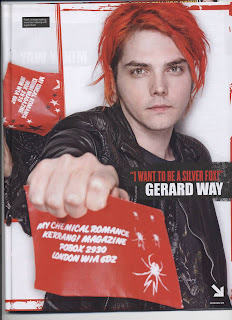This information was found on Wikipedia. (not copied and pasted) although some is my opinion.
For the main task, we have to create a music magazine. I'm going to research two magazines: Kerrang! and NME. This research will help me design my own magazine.
Kerrang! is a popular weekly magazine. In the magazine, it features successful bands as well as new bands. Kerrang! normally focuses on interviews and gig guides. Every week it has free posters, and sometimes free gifts such as CDs, stickers, giant posters etc.
Kerrang! is targeted at teenagers and young adults that are interested in rock/metal music. It is only £2.20, which personally, I think is a very good price for the quality of the magazine, plus, it is also a suitable price for teenagers.
The house style is always very "in your face". The banner is very recognisable, it aims to get noticed. Kerrang! gives the impression that it is a 'loud' magazine, it's tag line helps this idea - "Life is Loud". It always has previews of the posters included along the bottom of the OFC. Normally, right at the top and the bottom, it lists a few bands that are featured in the issue.
It is published by Bauer Consumer Media and distributed by Gordon and Gotch. The first issue was released on 7 June 1981 and AC/DC were on the OFC. The original owner of Kerrang! was United Newspapers, it was then sold to EMAP in 1991. In 2008 EMAP sold Kerrang! to Bauer Consumer Media. Paul Rees was the editor from 2000-2003 but he quit to edit "Q". Nichola Brown is the current editor of Kerrang!
Social groups are represented as music-obsessed, but in a good way. They are also represented as fun, and that they can take things not so seriously.
Over time, there are certain bands that keep cropping up on the OFC again and again, for example: My Chemical Romance, Avenged Sevenfold and Slipknot. Kerrang! has a feedback page, readers can write in and ask for certain bands to be interviewed, also they give their feedback on previous issues, to help Kerrang! improve.
Sometimes, Kerrang! releases 'specials'. For example, a few years ago there was a Metallica special. Recently, there was a special on My Chemical Romance, there was a OFC for each member of the band.
















































